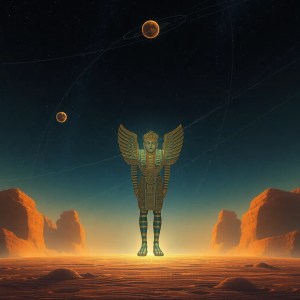Atenism and Its Influence on the Development of Religious Thought
I. Introduction
Atenism, a revolutionary religious movement that emerged during the 14th century BCE, represents a significant shift in the spiritual landscape of Ancient Egypt. Defined by the exclusive worship of Aten, the sun disk, Atenism introduced a form of monotheism that challenged the traditional polytheistic practices of the time.
The historical context of Atenism is particularly noteworthy, as it arose during the reign of Pharaoh Akhenaten, a figure whose radical reforms altered the course of Egyptian religion. This article aims to explore the origins, beliefs, practices, challenges, decline, and lasting influence of Atenism, shedding light on its significance in the evolution of religious thought.
II. The Origins of Atenism
The roots of Atenism can be traced back to the complex tapestry of Ancient Egyptian religion, which was characterized by a vast pantheon of gods and goddesses. Polytheism was deeply integrated into every aspect of life, with deities representing natural forces, fertility, the afterlife, and more.
Key figures in the establishment of Atenism include Akhenaten, who was initially known as Amenhotep IV. His reign marked a transformative period when he promoted the worship of Aten above all other gods. Akhenaten’s radical departure from traditional worship was part of a broader vision to consolidate religious and political power.
The transition from polytheism to monotheism under Akhenaten was unprecedented. He sought to dismantle the existing religious structure, diminishing the influence of the powerful priestly class associated with the traditional gods.
III. Core Beliefs and Practices of Atenism
Atenism is primarily defined by the worship of Aten as the singular god. Unlike other deities who were often depicted in anthropomorphic forms, Aten was represented as a sun disk radiating light, emphasizing the life-giving power of the sun.
- Rituals and Practices: The practices associated with Atenism were relatively simple compared to the elaborate rituals of polytheism. Daily offerings were made to the sun disk, and prayers were directed to Aten, highlighting the direct relationship between the deity and the worshippers.
- Art and Architecture: A distinctive feature of Atenism was its unique artistic style. The temples built for Aten, such as the one at Akhetaten (modern-day Amarna), were designed to be open-air structures that allowed sunlight to illuminate the worship space. Art from this period often depicted the royal family in intimate and naturalistic settings, emphasizing their connection to Aten.
IV. Atenism’s Challenge to Traditional Egyptian Religion
Atenism posed a direct challenge to traditional Egyptian religion, particularly through its critique of the established priestly class and polytheistic worship. Akhenaten’s reforms undermined the power and influence of the priests of Amun, who had long dominated the religious landscape.
The ideological conflict with established religious practices was profound. The traditional rituals and multiple gods that had sustained Egyptian society for centuries were suddenly deemed unnecessary and inferior when compared to the worship of Aten.
Responses from traditional religious leaders and the populace were mixed. While some embraced the change, others resisted, leading to tensions that would persist throughout Akhenaten’s reign.
V. The Decline of Atenism
The decline of Atenism came swiftly after Akhenaten’s death. Several factors contributed to its fall, including:
- The lack of a strong political and religious successor to Akhenaten.
- The resurgence of the priestly class, who sought to restore the worship of traditional deities.
- The general populace’s preference for the familiar rituals and gods of their ancestors.
As a result, the practices of Atenism were largely erased, and polytheism was restored during the reign of Akhenaten’s successors, particularly Tutankhamun. Atenism’s temples were dismantled, and references to Aten were systematically removed from records.
Despite its decline, Atenism left an indelible mark on the religious landscape of Ancient Egypt, representing a moment of profound theological innovation.
VI. Atenism’s Influence on Later Religious Thought
Atenism’s revolutionary ideas have drawn parallels with later monotheistic religions. Some scholars suggest that the concept of a singular divine entity can be seen in:
- Judaism: The emphasis on a singular God in Jewish tradition resonates with the monotheistic practices initiated by Atenism.
- Christianity: The idea of a singular divine presence continues into Christianity, with the portrayal of God as a singular, all-powerful being.
Atenism can thus be viewed as a precursor to philosophical and theological discussions about the nature of divinity and the role of humanity in relation to a singular god.
VII. Scholarly Interpretations of Atenism
Contemporary academic perspectives on Atenism are diverse, encompassing various interpretations and analyses of its significance. Archaeological discoveries, such as the ruins of Akhetaten, have provided valuable insights into the practices and beliefs of this unique religious movement.
Debates surrounding the significance of Atenism in global religious history continue to evolve, with scholars examining its influence on monotheistic traditions and its role in the broader context of religious development.
VIII. Conclusion
In summary, Atenism represents a crucial turning point in the evolution of religious thought, showcasing the complexities and dynamics of belief systems in Ancient Egypt. Its contributions to monotheism and critiques of polytheistic traditions laid the groundwork for future theological developments.
The enduring impact of Atenism continues to resonate in modern spirituality, prompting reflections on the nature of faith, divinity, and the human experience. Studying ancient religions like Atenism is essential for understanding contemporary beliefs and the historical contexts that shape them.




